The first images beamed back from NASA’s James Webb Space Telescope (JWST) have stunned the world this year. Launched on Christmas Day 2021, it took a month to arrive at its destination in space, a gravitational sweet spot 1.5 million kilometres further out into the Solar System. It then underwent an extraordinary sequence of deployment, unfurling a tennis-court-sized sunshield and unfolding a segmented mirror measuring 6.5 metres in diameter before any further work could take place.
Once everything was powered up and online, operators began the painstaking job of commissioning the instruments and making sure everything was working correctly.
The JWST is the largest telescope ever launched into space. It works at infrared wavelengths of light. These are rays that have a longer wavelength than the light we can see with our eyes. We generally perceive infrared radiation to be heat, which is why so-called ‘thermal cameras’ are infrared in nature.
Finally, on 11 July 2022, we got to see its first images. And they were breathtaking. Giant celestial landscapes of dust and gas were revealed, as were the deepest reaches of the Universe. There were huge, interacting galaxies, and dying stars in their final throes of life.
But the images themselves, however mind-blowing, are just the tip of the iceberg. Behind them are mountains of data that are set to reshape our understanding of the Universe. From the deepest realms of the cosmos all the way home to the celestial backyard of our Solar System, there is not a single domain of the Universe that the JWST cannot make a meaningful investigation.
In truth it is still early days for the actual results. Astronomers around the world are still getting used to the data that is now streaming down to Earth. But it is very clear that the JWST looks set to fulfil every science promise and then some.
The early Universe
One of the JWST’s science objectives is to look into the distant reaches of the Universe to see how the first galaxies were born. It can do this because light takes billions of years to cross our cosmos. When the JWST collects this light, it is seeing those objects as they looked billions of years ago.
To reflect this fact, astronomers refer to distances in light-years, which is the distance light can travel in a year. And the first image to be released by the team highlighted this point. It was unveiled on 11 July 2022 by US President Joe Biden, speaking from the White House, and it was a ‘deep field’ image.

Deep fields came to prominence in 1995 when the Hubble Space Telescope peered at a single patch of sky for 10 consecutive days, starting on 18 December. The selected patch was little more than a tiny speck, about one 24-millionth of the whole sky. Yet Hubble revealed around 3,000 previously unknown objects, mostly galaxies that are billions of light-years away. Centred around the galaxy cluster SMACS 0723, the JWST’s deep field spans a similarly minuscule patch of sky.
“It’s the equivalent to having a grain of sand and holding it at arm’s length, while standing on Earth. That grain of sand will blot out a small sliver of the sky, and yet there are thousands of galaxies and features that we’ve never seen before just in that one image,” says Caroline Harper, head of space science at the UK Space Agency.
SMACS 0723 itself is 4.6 billion light-years away. Its mighty gravitational field acts like a magnifying glass to more distant galaxies behind. Where the gravitational field is the strongest, it distorts the background galaxies into great arcs. In one case, the light from a distant galaxy was measured to have been travelling through space for 13.1 billion years before being collected by the telescope.
As the Universe expands, it stretches the light that is being emitted. The JWST’s main target galaxies are so far away that the stretching has transformed the visible light from their stars into infrared. So by collecting those wavelengths, astronomers can compare the JWST’s observations directly with the visible light images of closer galaxies from Hubble and other observatories. This will reveal the way galaxies evolve through cosmic time, growing larger and building up into the shapes we see today.
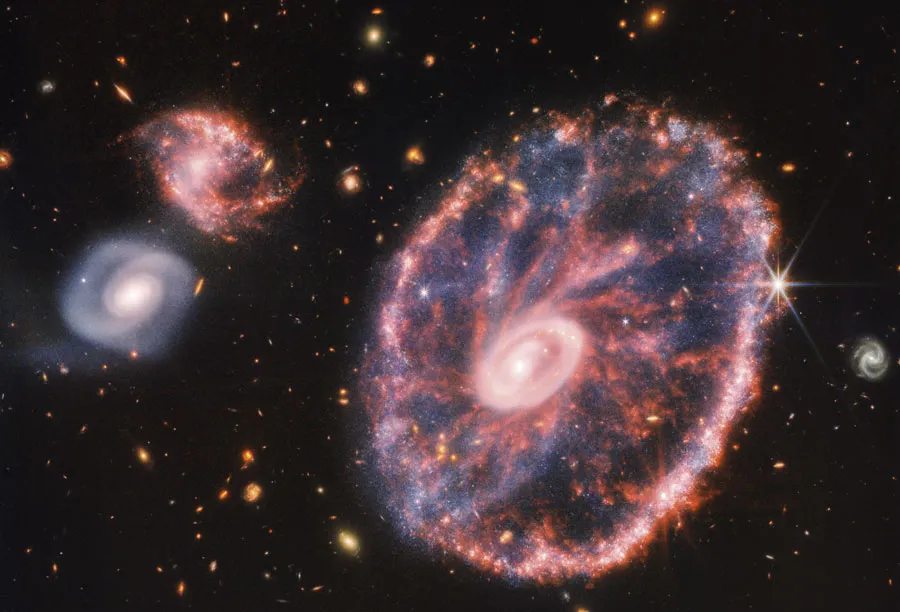
Perhaps the most amazing thing about the JWST’s first deep field image is not just the number of galaxies, but the speed with which it can take such images – just hours, rather than days. In fact, it cannot help but detect galaxies almost everywhere it looks.
“The one big feature that jumps out with all the data is the fact that there’s just so many galaxies. Everywhere you point – particularly in the near-infrared – you don’t even have to integrate for very long, and you’re gonna have like 200 galaxies all over the place,” says Sarah Kendrew, an instrument and calibration scientist for the European Space Agency.
It is not only galaxy clusters that are serving as magnifying glasses. The JWST’s image of a pair of galaxies, catalogued as VV191, was taken so that the scientists could analyse how light from one of the pair changed as it passed through the other. The analysis will betray the characteristics of the dust in the intervening galaxy.
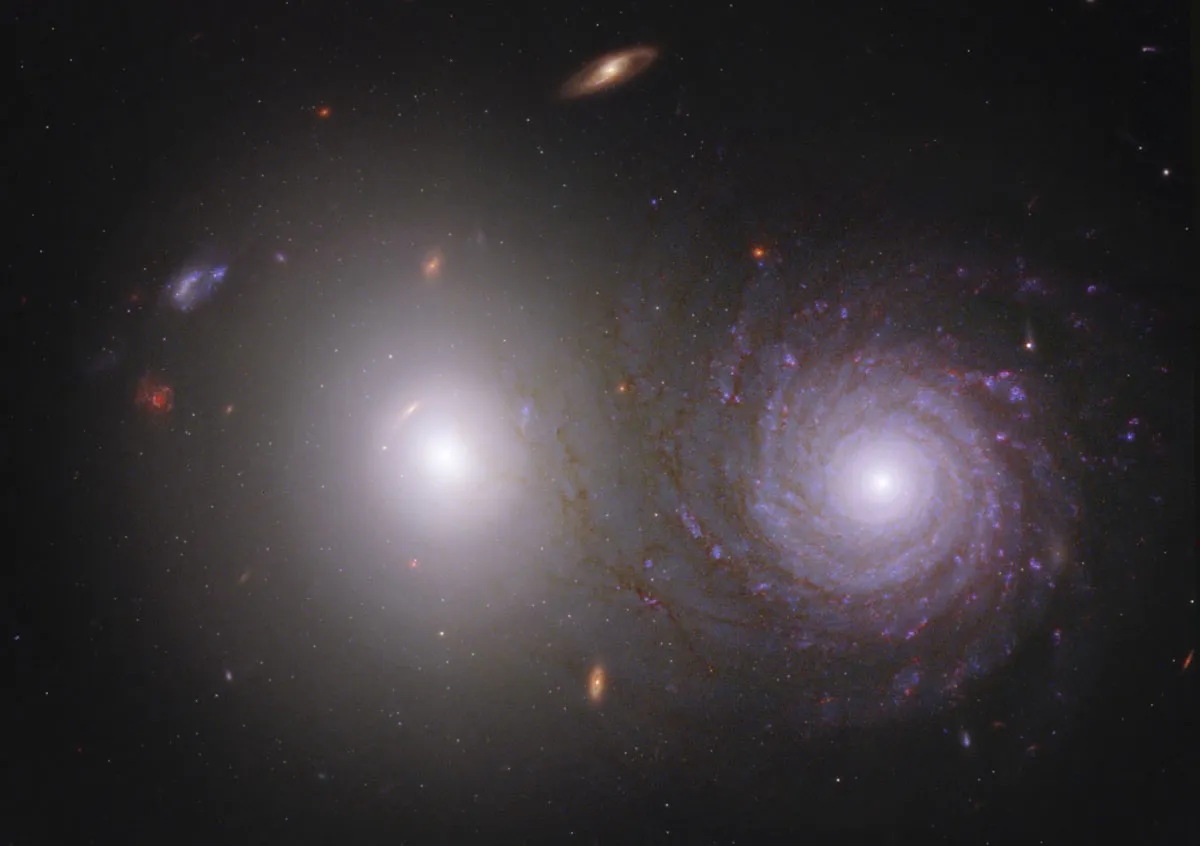
Astronomers noticed that the telescope had also captured the faint arc of an even more distant galaxy, distorted by one of the galaxies they were studying. Because the lensed galaxy’s shape depends on the mass of the lensing galaxy, they now have a way of measuring the mass of the galaxy that they did not have before.
Galaxies and black holes
One of the first images released by the JWST was of a small group of galaxies known as Stephan’s Quintet. This collection of galaxies features four galaxies that are so close to one another that they are gravitationally interacting. The fifth galaxy in the grouping merely appears close. In reality, it is much closer to us and just happens to lie in the same line of sight.
Together, the quartet of interacting galaxies form a ‘laboratory’ in which astronomers can study the way galaxies interact and merge with each other. Such mergers are thought to have been exceptionally common in the early Universe, where they were the principal route for galaxies to grow into the gigantic star cities we see around us today. The mergers are also thought to be responsible for the growth of supermassive black holes, an example of which now lies in the centre of every galaxy.
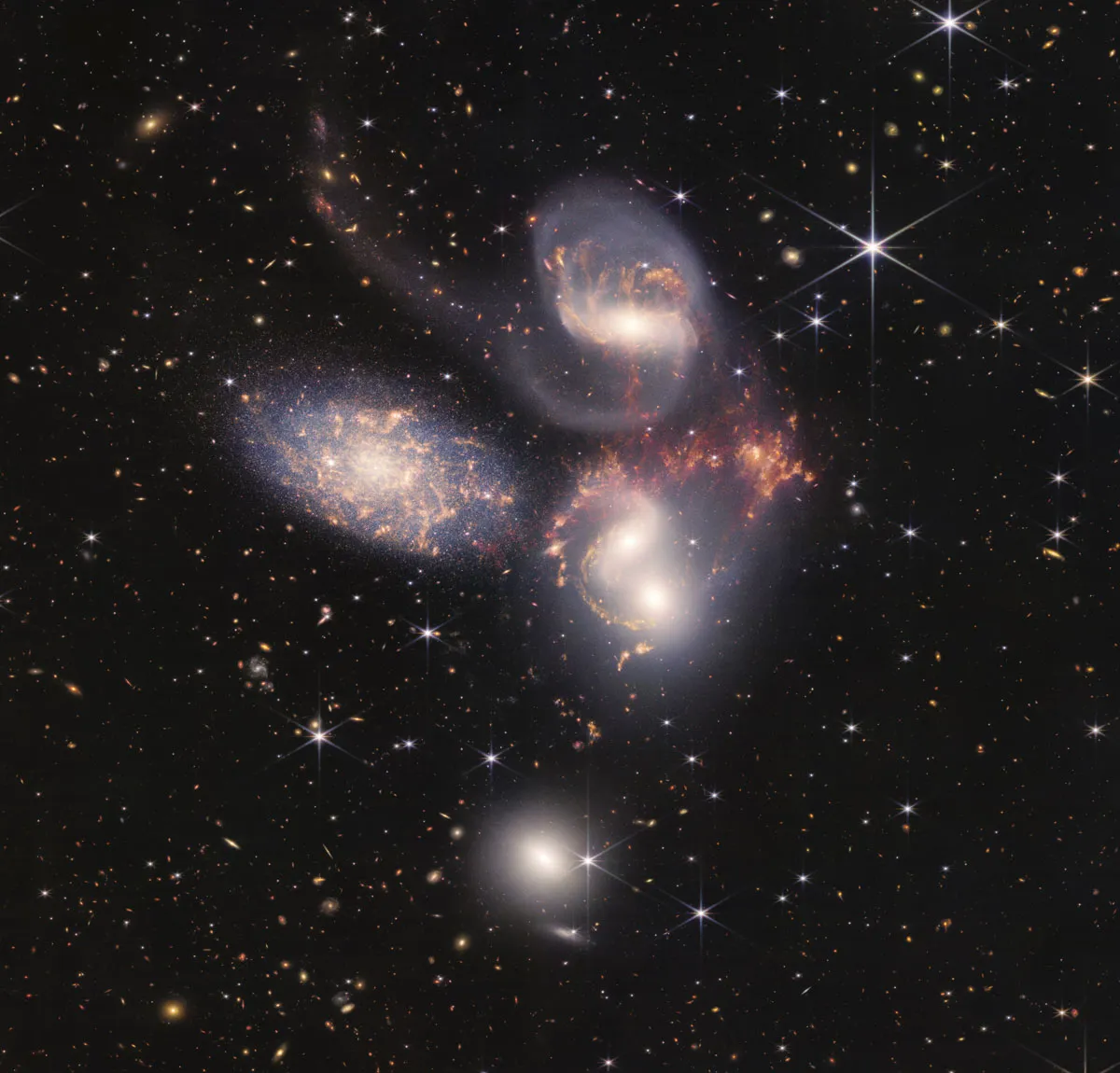
The JWST studied Stephan’s Quintet with its NIRCam and MIRI instruments. In particular, the MIRI images came as a surprise because the shapes of the galaxies were not what astronomers were expecting.
The Phantom Galaxy M74 also provided the MIRI instrument with another stunning success. Located 32 million light-years away, M74 is a spiral galaxy that we see almost exactly face-on. It is a favourite for studying the giant spiral arms that give spiral galaxies their name. But no one has seen it so clearly before. The spiral arms of the galaxy, where star formation is taking place, can be seen for the first time reaching down into the very centre of the galaxy.
As well as the brand-new discoveries that everyone hopes the JWST will make, collaborations will also be a major focus, combining the telescope’s new observations with those from other observatories in order to unlock a greater understanding of the celestial objects being studied.
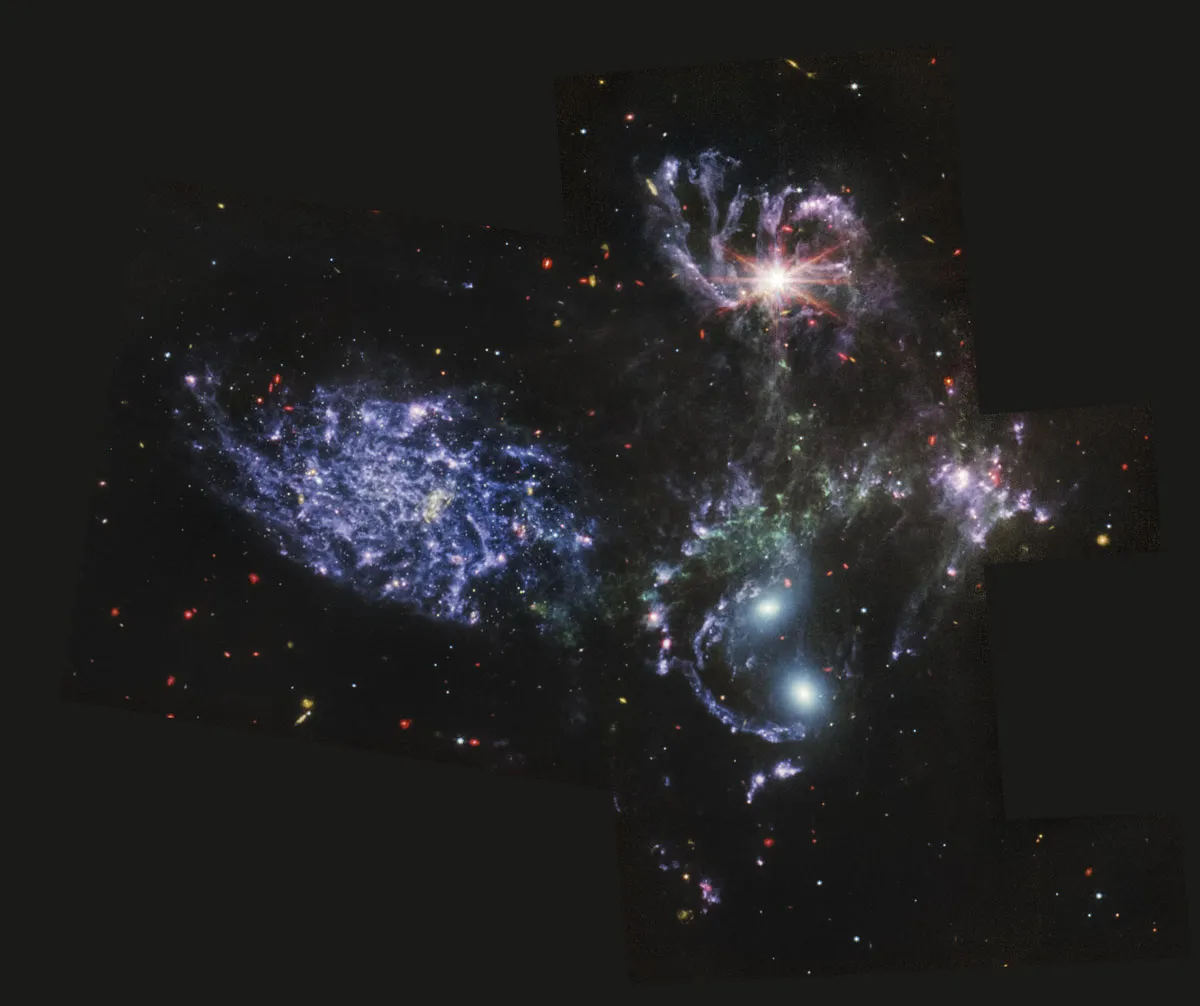
For example, the observations of M74 are part of a larger effort to target 19 nearby star-forming galaxies. These galaxies have already been imaged by Hubble and various ground-based observatories. The JWST’s observations will allow astronomers to more accurately pinpoint star-forming regions, measure the masses and ages of star clusters, and uncover the physical and chemical nature of the dust grains drifting through the galaxies.
The life cycle of stars
One area in which infrared astronomy excels is looking deep into the clouds where stars are forming. This is because longer wavelengths are scattered less by atoms, molecules and dust grains. In effect, the very things that block our view of the stellar nurseries at visual wavelengths become almost transparent in the infrared.
Another image to be released from the JWST was NIRCam’s view of the star-forming region NGC 3324 in the Carina Nebula, located 7,500 light-years away.
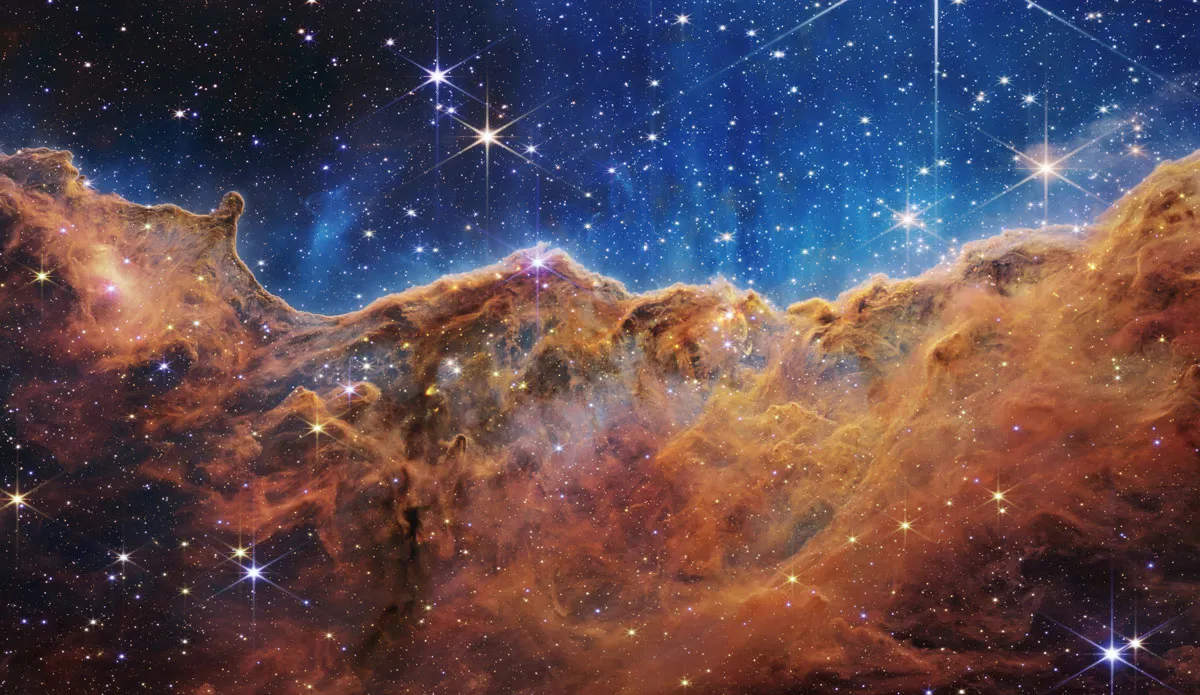
“The Carina Nebula is stunning. We know it’s gas and dust being carved by starlight, but it looks like a landscape. The fact that you can now see inside it, using the infrared, is amazing. What’s been private before is now visible in all its glory,” says Harper.
At the time of release, it was dubbed ‘the cosmic cliffs’ because of the way the great gaseous cliffs appeared to resemble a mountain range. In reality, it was the edge of a giant cavity being gradually eroded by powerful ultraviolet light from newborn stars.
The stars are located off the top of the image but their action has blown a bubble in the surrounding material. The erosion can be seen taking place in this image because of the presence of what looks like steam coming off the landscape. This is actually hot gas, electrified by the stars’ light, lifting off the denser surrounding matter. It is carrying some of the dust with it. The image spans roughly 12 light-years.
One of the most iconic pictures ever released by Hubble was of the Pillars of Creation. These are the star-forming regions in a much larger cloud of interstellar gas known as the Eagle Nebula. The JWST has now observed this same region using its NIRCam and MIRI instruments, to peer deeper into the massive stellar birthing ground than ever before.
Read more about the James Webb Space Telescope:
- 10 James Webb Space Telescope memes that are out of this world
- NASA’s James Webb telescope spots ‘sparkling’ galaxy that may contain the oldest stars ever seen
- Why do all the stars have 8 points in the James Webb images? An astronomer explains
One highlight of the new NIRCam image is the occasional bright orange features seen near the ends of the ‘fingers’. These are shock waves produced by young stars inside that have just begun to generate energy by nuclear fusion. As those powerful processes began, huge jets of material are ejected at supersonic speeds that collide with the dusty cocoon surrounding each star, blowing this material away and revealing the newborn star to the Universe.
Shifting from the near-infrared image to MIRI’s mid-infrared range reveals a similar but eerily different scene. Most of the stars have now disappeared because they are simply not that bright at these wavelengths. Instead, the dusty pillars are highlighted because of emissions coming from naturally occurring chemicals known as polycyclic aromatic hydrocarbons.
But perhaps most excitingly, there are one or two instances where bright stars can be seen at the ends of the gaseous fingers. These are the young stars themselves, and each one could be attended by a solar system of planets.
And even though the team behind MIRI had always had this observation in mind, the end result still took them by surprise. “We’ve planned to do it for all these years, we knew it would be exciting. But it’s different when you actually see it, and you have the data. I think it’s just really exciting,” says Gillian Wright, the European principal investigator for MIRI.
By revealing more details than ever before, the JWST’s new views of the Pillars of Creation will help researchers test their knowledge of star formation, and improve their computer models of the process. Understanding more about the precise number of young stars in these regions, and the spread of masses, along with the actual quantities of gas and dust that make up the nebula, is vital for understanding the way galaxies replenish their supply of stars.
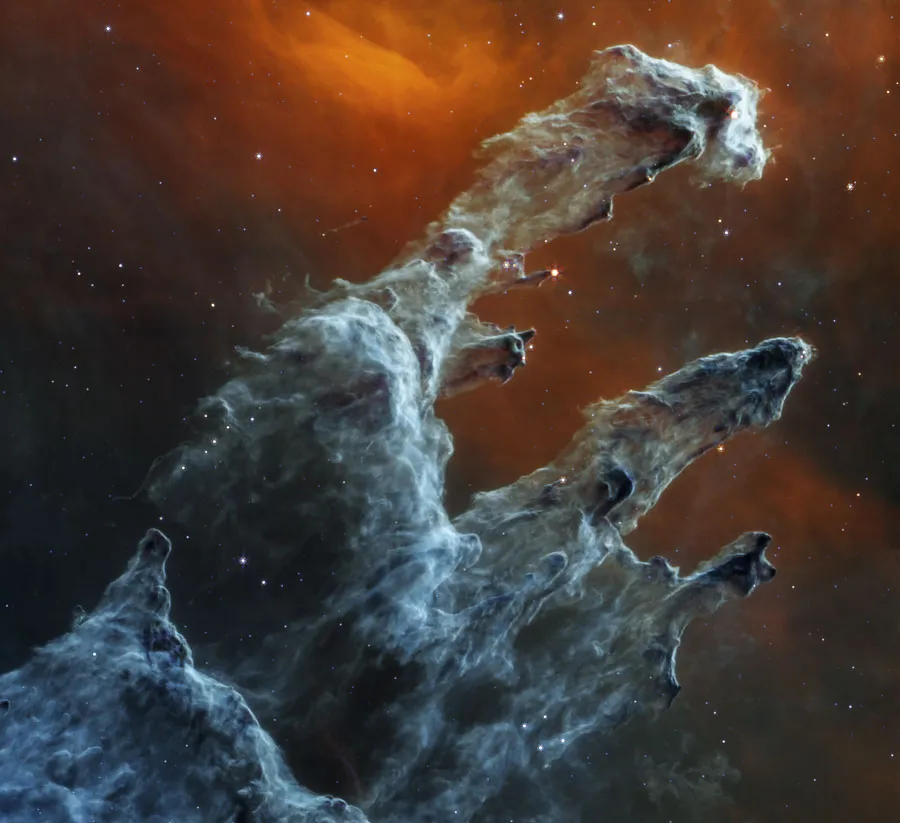
At the other end of the stellar life cycle, the JWST has also been revealing the way stars die. Stars like the Sun swell to become red giant stars and then collapse into compact stellar corpses known as white dwarfs. In this collapse, they eject their outer layers to form a so-called (but woefully misnamed) planetary nebula. The JWST’s image of the Southern Ring Nebula shows how beautiful this process can be.
For thousands of years before it became a white dwarf, the star would periodically eject shells of matter from its outer layers. What was left of the star would then contract and heat up, sparking a new round of energy generation that would set off a new round of pulsation, leading to the ejection of another shell of material. On and on this went until there was simply not enough remaining matter to squeeze the star’s core sufficiently to spark nuclear fusion any more. At this point, it became a white dwarf. This is the fate that awaits our own Sun in around 4.5 billion years.
Exoplanets
When it comes to planets beyond our Solar System, not even the JWST can deliver a detailed image. An exoplanet, especially one the size of Earth, is so small and dim compared to its central star that it will take a dedicated space mission using numerous space telescopes working together in clever ways to produce anything with any level of detail at all. Nevertheless, the JWST has managed to take one exoplanet image.
The planet is called HIP 65426 b. It is somewhere between six to 12 times the mass of Jupiter and orbits its star about 100 times further than Earth is from the Sun. To see the alien world, the JWST used devices called coronagraphs on its NIRCam and MIRI instruments.
A coronagraph blocks out the light from the central star, making the fainter surroundings easier to see. Its name comes from the fact that astronomers developed such an instrument to study the faint, outer atmosphere of our own Sun, which is called its corona. Now it can be used to see fainter objects such as exoplanets near distant stars.
Prof Sasha Hinkley, an astrophysicist at the University of Exeter, led these observations. “It was really impressive how well the Webb coronagraphs worked to suppress the light of the host star,” he said when NASA released the image on 1 September 2022.
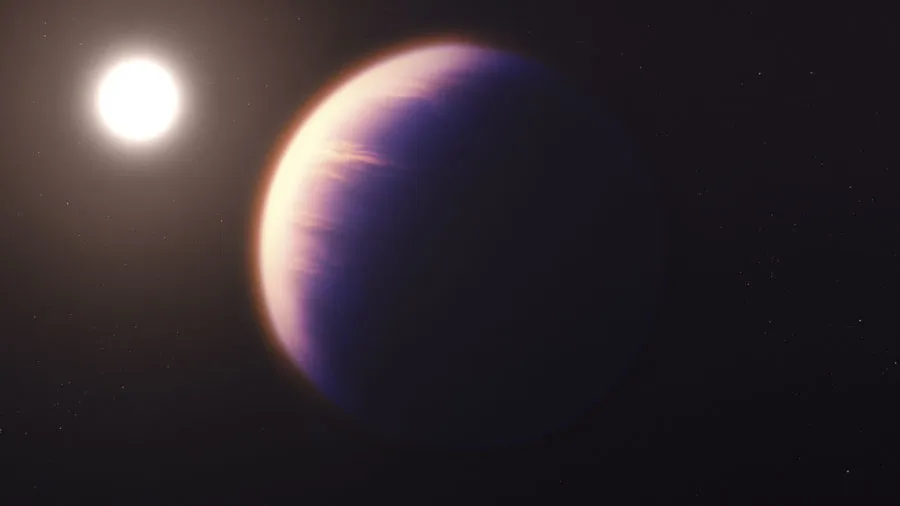
This is not the first direct image of an exoplanet ever taken from space, the Hubble Space Telescope had previously captured a direct image of a planet in orbit around the star Fomalhaut, but it is a proof of concept that the JWST can do this at infrared wavelengths.
But when it comes to exoplanet research, the JWST’s biggest contribution is undoubtedly its ability to break down the light it receives into spectra. Spectra are a measure of how much light at each wavelength is being received.
A lot of science can be extracted from spectra, because atoms and molecules each like to interact with different wavelengths. This creates a pattern of dark lines in the spectra that are effectively like fingerprints, each one unique to a specific atom or molecule. The JWST is so important in this regard because molecules really like to interact with infrared wavelengths. Hence, an infrared spectrum of a celestial object can reveal its chemical composition.
This is exactly what astronomers did with the JWST’s NIRISS instrument on the exoplanet WASP-96 b. The resulting graph showed the distribution of infrared light from 0.6 to 2.8 micrometres. WASP-96 b is notable because it often passes in front of its parent star.
A small proportion of the star’s light therefore passes through the exoplanet’s atmosphere, where the constituent atoms and molecules absorb their preferred wavelengths. This shows up as a drop in the intensity at those wavelengths. In this particular case, the JWST showed that WASP-96 b contained water vapour in its atmosphere.

The planet is a ‘hot Jupiter’, so-called because it has a mass of around half that of Jupiter in our own Solar System, yet orbits so close to its star that a year lasts just 3.4 days. The results themselves are still preliminary because a computer model of the planet’s atmosphere must be constructed. The model includes things like the abundance of various gases in the planet’s atmosphere, and the height and thickness of any clouds in the exoplanet’s atmosphere.
The next phase of this research is to extend this work to smaller and smaller exoplanets, eventually analysing Earth-sized worlds. This is more difficult, because smaller worlds have less dense atmospheres, but astronomers are optimistic.
“The JWST opens the door to smaller planets and cooler planets, more similar to our own Earth. And it will allow us to study giant planets in much more detail than we’ve ever had access to before,” says Laura Kreidberg, an exoplanet expert from the Max Planck Institute for Astronomy, Germany. “I feel like we’re at the very, very beginning of a really exciting journey.”
Planetary systems
It is not just planets around other stars that the JWST has been looking at. It has also been targeting some of the planets in our own Solar System. In its first released image of Jupiter, different wavelengths from the NIRCam instrument were combined to create an image where brightness represented altitude in the Jovian atmosphere. The higher a feature is, the more infrared light it reflects, so the brighter it appears.
Jupiter’s Great Red Spot, for example, a storm system so large that it could engulf the entire planet Earth, is so high in the planet’s atmosphere that it appears extremely bright at infrared wavelengths. The deeper cloud layers and hazes appear much darker by contrast. The auroras show up at the northern and southern poles of the planet in this image too. They are created when particles trapped in Jupiter’s magnetic field are funnelled into the giant world’s atmosphere, where they strike atoms and molecules and cause them to fluoresce.
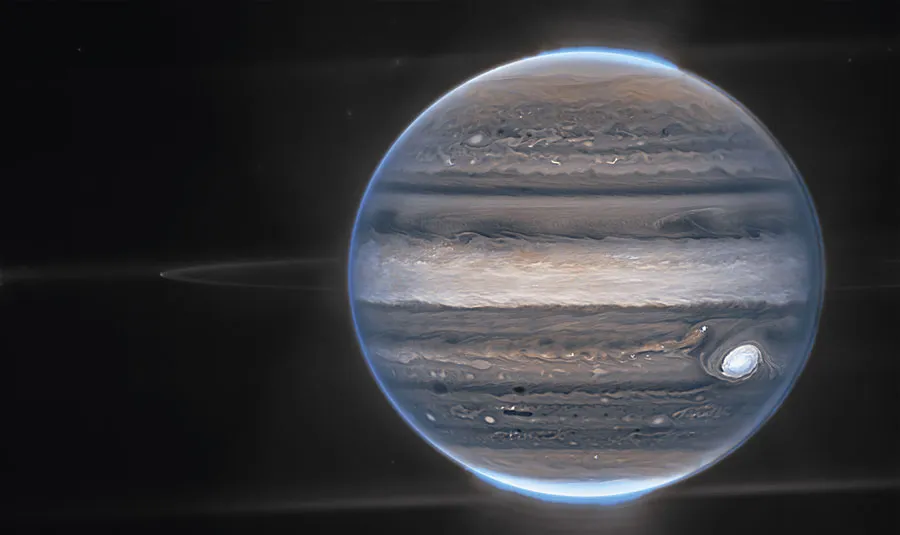
The JWST also focused NIRCam on distant Neptune. Six times further from the Sun than Jupiter, Neptune is not seen in so much detail but the results are similar. A series of bright patches in the planet’s southern hemisphere represent high-altitude methane-ice clouds, while a more subtle ring of brightness circling the planet’s equator could portray a kind of ‘jet-stream’, a circulating band of atmosphere that powers Neptune’s winds and storms.
One recent observational campaign that the JWST was well placed to assist with was the asteroid deflection test of Dimorphos. On 26 September, NASA’s DART spacecraft intentionally crashed headfirst into the small asteroid in order to test our ability to deflect an asteroid should one be found to be on a collision course with Earth.
This image was taken around four hours after the impact and shows the enormous dust cloud that was ejected from the collision. Analysing the amount of material that was blown into space by DART will allow theoreticians to understand more about the interior composition and structure of Dimorphos, and asteroids in general. This knowledge will be crucial when designing a mission to deflect an asteroid for real. In the months after the collision, the JWST has continued to observe Dimorphos in order to gain as much insight as possible.
And it is still early days. The images that have been released so far are more like proofs of concept rather than full scientific results. They represent a promise from the astronomers involved that the telescope is working, and that the analyses, results and breakthroughs will follow.
“It’s really fun and exciting at the moment. There’s something new in everything the JWST touches,” says Wright. “There’s something you look at and you go ‘wow!’”
Read more about the James Webb Space Telescope: